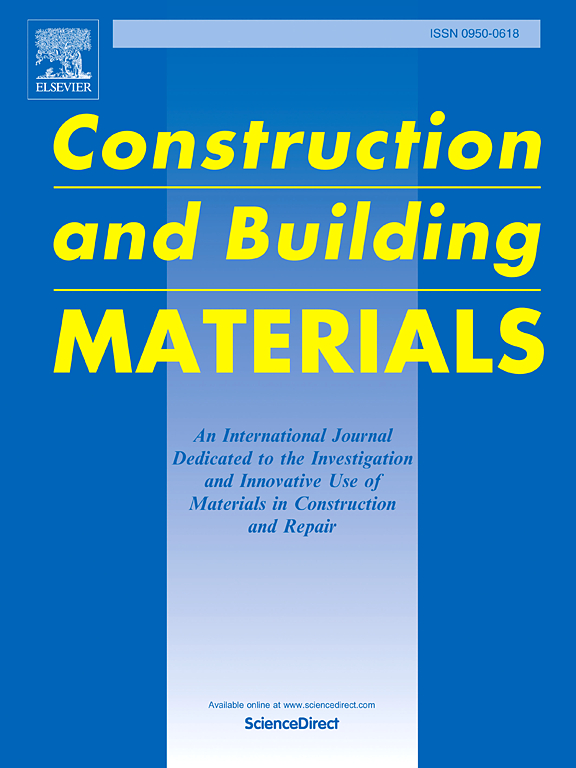GFRP筋在混凝土中的粘结强度与承载能力:试验与分析研究
IF 7.4
1区 工程技术
Q1 CONSTRUCTION & BUILDING TECHNOLOGY
引用次数: 0
摘要
在混凝土结构中越来越多地采用玻璃纤维增强聚合物(GFRP)钢筋,需要对其粘结行为进行彻底的了解。本文对GFRP筋在混凝土中的粘结性能和承载能力进行了试验和分析研究。试验研究了直径为8 mm、10 mm和12 mm的小直径GFRP筋在直管和端头结构下的粘结行为。直筋具有良好的粘结性能和承载能力,在埋置长度为15倍筋径(15db)时产生最大的粘结应力,导致GFRP筋断裂破坏。相反,对于直径为8 mm和10 mm的玻璃钢,端头杆(即长度为100 mm的大头和长度为50 mm的小头)的效果有限。这一发现表明,末端封头可能不是提高小直径GFRP筋承载能力的可行选择。在实验结果的基础上,提出了一个预测平均粘结应力的新方程。在第二阶段,使用从先前研究中提取的275个样本(占数据集的80% %)的数据对所提出方程的系数进行校准。该方程考虑了钢筋直径、预埋长度和混凝土抗压强度,同时区分了小直径和大直径玻璃钢钢筋。最后,使用69个随机样本(占数据集的20% %)对来自不同代码和研究的成熟模型进行验证,以证明所提出方程的令人满意的性能。与其他模型相比,所提出的方程显示出优越的荷载能力预测能力,特别是对于小直径GFRP筋,其积分绝对误差(IAE)和平均绝对误差(MAE)值分别为16.9 %和18.4 %。本文章由计算机程序翻译,如有差异,请以英文原文为准。
Bond strength and load-carrying capacity of GFRP rebars embedded in concrete: An experimental and analytical study
The increasing adoption of glass fiber-reinforced polymer (GFRP) rebars in concrete structures necessitates a thorough understanding of their bond behavior. This research presents an experimental and analytical study focused on the bond behavior and load capacity of GFRP bars embedded in concrete. The experiments investigate the bond behavior of GFRP bars with small diameters of 8 mm, 10 mm, and 12 mm in straight and end-headed configurations. Straight bars exhibited excellent bond performance and load capacity, developing most bond stress at an embedment length of 15 times the bar diameter (15db), resulting in the GFRP bars' rupture failure. Conversely, the end-headed bars (i.e., large heads with a length of 100 mm and small heads with a length of 50 mm) for GFRP diameters of 8 mm and 10 mm demonstrated limited efficacy. This finding suggests that end heads may not be a viable option for enhancing the load capacity in small-diameter GFRP bars. Based on the experimental results, a novel equation was proposed to predict average bond stress. In the second phase, the coefficients of the proposed equation were calibrated using data from 275 specimens (80 % of the dataset) extracted from previous studies. This equation incorporated bar diameter, embedment length, and concrete compressive strength while distinguishing between small- and large-diameter GFRP bars. Finally, it was validated against well-established models from different codes and research studies using 69 random specimens (20 % of the dataset) to demonstrate the satisfactory performance of the proposed equation. The proposed equation demonstrated superior predictive capability for load capacity, particularly for small-diameter GFRP bars, achieving the best performance with integral absolute error (IAE) and mean absolute error (MAE) values of 16.9 % and 18.4 %, respectively, compared to other models.
求助全文
通过发布文献求助,成功后即可免费获取论文全文。
去求助
来源期刊

Construction and Building Materials
工程技术-材料科学:综合
CiteScore
13.80
自引率
21.60%
发文量
3632
审稿时长
82 days
期刊介绍:
Construction and Building Materials offers an international platform for sharing innovative and original research and development in the realm of construction and building materials, along with their practical applications in new projects and repair practices. The journal publishes a diverse array of pioneering research and application papers, detailing laboratory investigations and, to a limited extent, numerical analyses or reports on full-scale projects. Multi-part papers are discouraged.
Additionally, Construction and Building Materials features comprehensive case studies and insightful review articles that contribute to new insights in the field. Our focus is on papers related to construction materials, excluding those on structural engineering, geotechnics, and unbound highway layers. Covered materials and technologies encompass cement, concrete reinforcement, bricks and mortars, additives, corrosion technology, ceramics, timber, steel, polymers, glass fibers, recycled materials, bamboo, rammed earth, non-conventional building materials, bituminous materials, and applications in railway materials.
 求助内容:
求助内容: 应助结果提醒方式:
应助结果提醒方式:


